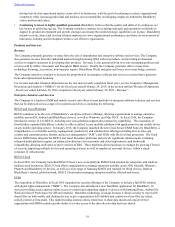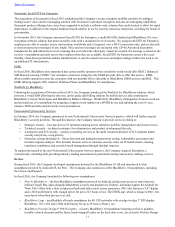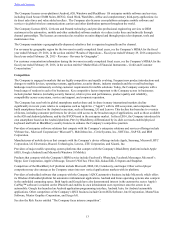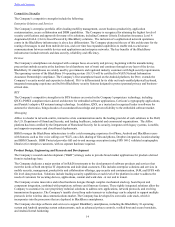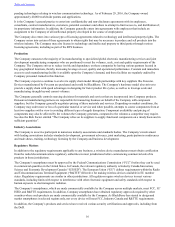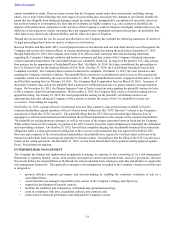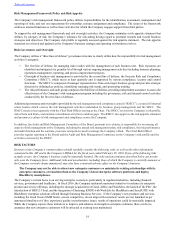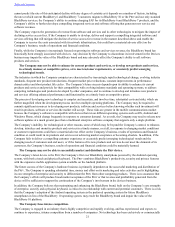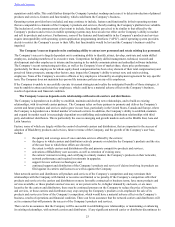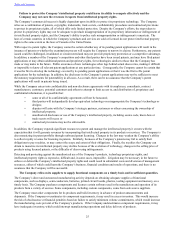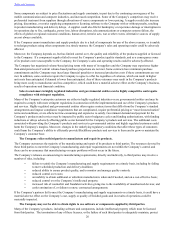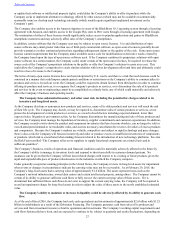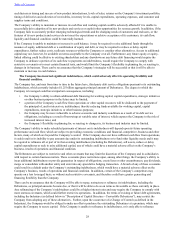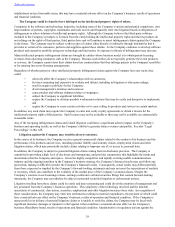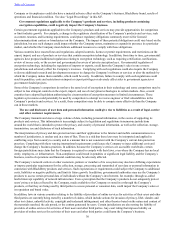Blackberry 2016 Annual Report Download - page 29
Download and view the complete annual report
Please find page 29 of the 2016 Blackberry annual report below. You can navigate through the pages in the report by either clicking on the pages listed below, or by using the keyword search tool below to find specific information within the annual report.
Table of Contents
20
Sales to large enterprise customers involve risks that may not be present (or that are present to a lesser extent) with sales to
smaller entities. These risks include:
• more complicated infrastructure requirements, which result in more difficult and time-consuming implementation
processes;
• complex IT systems, mobile environments and data privacy and security requirements;
• budget constraints, multiple approvals, lengthy contract negotiations, and unplanned administrative, processing and
other delays;
• increased purchasing power and leverage held by large customers in negotiating contractual arrangements with the
Company, including more pressure for discounts and other customer-favourable contractual terms;
• longer sales cycles, making it difficult to predict whether and when a sale will be completed, and the associated risk
that substantial time and resources may be spent on a potential customer that ultimately elects not to purchase the
Company’s products or services, or purchases fewer products or services than expected;
• customer deferral of purchasing decisions pending adoption of technology by others or pending potential consolidation
in the market;
• closer relationships with, and dependence upon, large technology companies that offer competitive solutions; and
• more intense and time-consuming customer support practices.
In addition, the Company has encountered challenges due to the impact of BYOD strategies and other flexible mobile
deployment models adopted by its enterprise customers. To address this evolution of the market, the Company has introduced
new cross-platform solutions and new, more competitive BlackBerry smartphones, as described in this AIF. There can be no
assurance that these new product and service offerings will enable the Company to successfully address the challenges it faces
from the trend toward flexible deployment models in the enterprise space, either with existing or new customers.
The Company spends substantial time, money and effort on its sales activities without any assurance that its efforts will produce
any sales. If the Company is unable to increase sales of the Company’s products and services to large enterprises while
mitigating the risks associated with serving such customers, the Company’s results of operations could be materially impacted.
The Company may not be able to develop, market and distribute an integrated software and services offering, or
otherwise monetize its technologies, to grow revenue, achieve sustained profitability, or offset the decline in the
Company’s service access fees.
The Company is increasingly focusing its strategy on software and services to grow revenue and generate sustainable
profitability.
For the Company to increase its software and services revenues, it must continually grow its customer base by attracting new
customers or, in the case of existing customers, deploying software and services on more devices or attracting additional users
in such existing customers’ businesses. The Company also needs to sell additional software and services over time to the same
customers, or have customers upgrade their level of service. If the Company’s efforts to sell or upsell software or services as
described above are not successful, its results of operations could be materially impacted.
Existing customers that purchase the Company’s software and services have no contractual obligation to renew their annual
subscriptions or purchase additional solutions after the initial subscription or contract period. The Company’s customers’
expansion and renewal rates may decline or fluctuate as a result of a number of factors, including the perceived need for such
additional software and services, the level of satisfaction with the Company’s software and services, features or functionality,
the perceived reliability of the Company’s software and services, the Company’s customer support, customer budgets and other
competitive factors, such as pricing and competitors’ offerings. For smaller or simpler deployments, the switching costs and
time are relatively minor compared to traditional enterprise software deployments and such a customer may more easily decide
not to renew with the Company and switch to a competitor’s offerings. Accordingly, the Company must invest significant time
and resources in providing ongoing value to these customers. If these efforts fail, or if the Company’s customers do not renew
for other reasons, or if they renew on terms less favourable to the Company, the Company’s revenue may decline and its results
of operations could be materially impacted.
The Company’s ability to grow software and service revenue is also dependent on its ability to expand its distribution
capabilities with indirect partners, resellers and carriers, as well as building a direct sales force, which requires significant time
and resources, including investment in systems and training. There can be no assurance that the Company will be successful in
implementing its distribution strategy. See also the Risk Factor entitled “The Company’s success depends on its relationships
with network carriers and distributors”.
For the past few years, the Company has experienced continued significant erosion of service revenue from service access fees
(“SAF”) charged to subscribers using BlackBerry 7 and prior BlackBerry operating systems. While the Company expects that
these subscribers will continue to generate service revenue, the amount of those revenues is expected to continue to decline in
the coming quarters, particularly as users of BlackBerry Bold and BlackBerry Curve smartphones upgrade to BlackBerry
devices (such as the Classic and PRIV) that do not generate service access fees, or to a competitor’s smartphone. The Company


